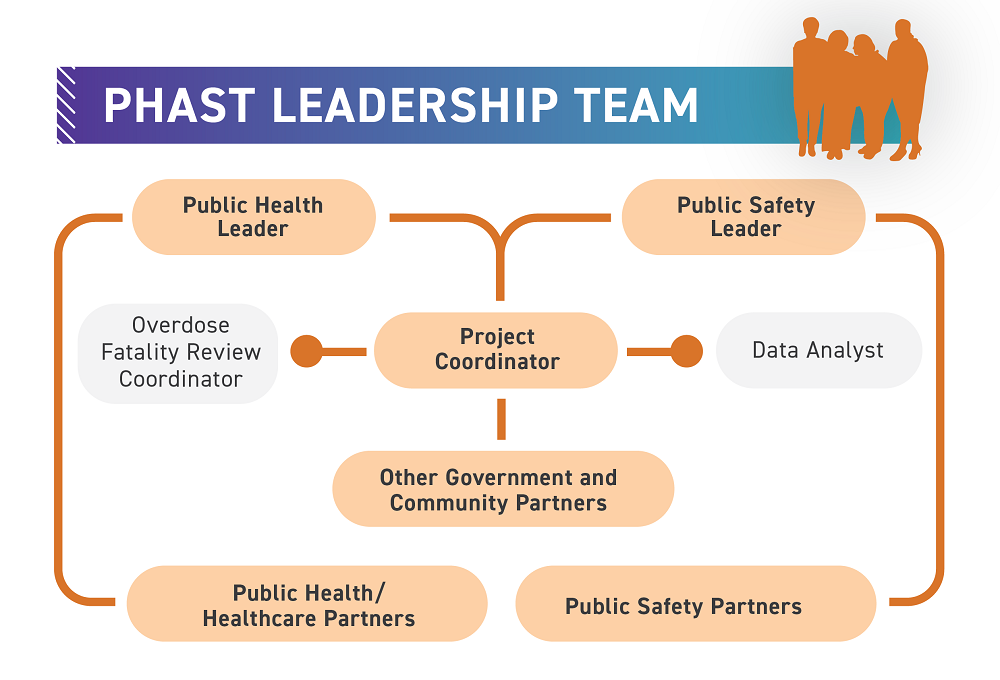
Building or Formalizing a PHAST: How to structure and organize your overdose prevention multi-sector collaborative
Preventing overdose deaths is possible. By coordinating efforts among diverse agencies, jurisdictions can leverage the collective knowledge, data, and skill sets available to them and share insights and resources for effective intervention strategies unique to each field. This module offers a formal structure and set of steps to help form and sustain these partnerships.
 Action Steps
Action Steps Whether you are forming a multi-sector team for the first time or applying the PHAST framework to an existing taskforce or partnership, we suggest the following critical elements.
We suggest leadership spend time assessing the extent to which their PHAST has these elements in place. Engaging in this process can help identify potential challenges, strengths, and opportunities for renewed commitment or reinvestment, as well as set realistic expectations from the start.
Leadership may also choose to discuss strengths and challenges related to each element to help determine what resources can be leveraged and what challenges can be addressed in the short term and over time. Strategies for achieving suggested prerequisites are discussed in the toolkit.
The organizational structure of your PHAST will vary depending on existing taskforces and resources already engaged in local opioid overdose response. At a minimum, the following are suggested:

For larger jurisdictions with many PHAST partner agencies, you may also consider developing data-driven implementation workgroups to implement interventions that span multiple sectors or require coordination. Examples of possible workgroups include:
These workgroups can help optimize jurisdictional capacity by developing and implementing plans based on prioritized improvement strategies identified by the PHAST.
PHASTs are encouraged to engage a diverse set of partners and include those in leadership positions who can speak with authority regarding potential programmatic and policy change for their agency. Both public health and public safety partners can play a variety of roles in a PHAST, depending on their area of expertise.
PHASTs also are encouraged to connect with people in recovery who are involved in advocacy work or have experience working in coalitions and partners who regularly interact with people at risk of overdose, such as certified peer recovery specialists and other front-line staff. These individuals can offer key insights into service gaps, access barriers, and opportunities for improvement.
Leaders of local community organizations that may not be directly involved in overdose prevention or response programs are another important group to engage. Often, members of community organizations have insight into existing culturally appropriate interventions and approaches to engaging their community.
Finally, PHASTs can build relationships with partners that steward key data sources, such as those from the state or county health department. For a list of suggested agencies and sectors, see Table 4 in the PHAST Toolkit.
When potential partners are first invited to participate in a PHAST, it is important that they understand their role and responsibilities. Sharing the following information can help potential partners determine their ability to commit and the degree to which they are able to engage with PHAST activities.
Having an orientation plan may be particularly helpful during this process. A standard orientation plan can help ensure that all partners new to the PHAST have a basic understanding of the PHAST framework, purpose, and goals, and for existing teams, knowledge of its team members and awareness of its accomplishments, decisions, and identified priority areas.
Each partner’s level of engagement in the PHAST will vary based on their individual role, sector, interests, and capacity. This may change over the course of a PHAST.
Understanding the different levels of engagement and how this may change over time can help the PHAST leadership team leverage partner resources, skills, and expertise and align expectations and responsibilities based on each partners’ capacity.
Before diving directly into sharing data with one another, it is important to establish some level of partnership building and trust. Partners may need to begin by sharing insights as opposed to data (e.g., sharing roles, experiences, perceptions, challenges, job requirements, and limitations). Sharing stories about the way the overdose crisis impacts your day-to-day work may be a way to start strengthening trust. Each partner brings valuable perspectives that can be shared.
A key to maintaining a PHAST is a shared acknowledgment of and belief in the four guiding principles and in multi-sector collaboration. This helps align collective action, foster collaboration, and maintain progress. Integrating the guiding principles into the foundation of your PHAST’s work can help partners navigate challenges and work as a cohesive and effective multi-sector team.

One approach is to establish an understanding of each other’s roles in the context of the overdose crisis, including key differences between public health and public safety approaches, unique strengths, and shared commonalities. This knowledge can help bridge the gap between diverse sectors. For an additional resource, see “Why are public health and public safety critical PHAST partners?”
Discussing and incorporating principles of diversity, equity, and inclusion into work processes and standard practices can help a PHAST identify their shared expectations and decide how the PHAST can work towards promoting these principles in their collective actions and decision-making. This may also be an opportunity to introduce partners to the topic of stigma and the use of stigma-reducing language (See ‘Stigma Reducing Language’ in Module 1).
A memorandum of understanding (MOU) is a formal agreement between two or more parties to establish mutual support, commitment, and shared understanding of their collaboration. MOUs can be used to clearly specify roles and responsibilities of each partner. Leadership may consider formalizing agency partnerships participating in a PHAST by establishing a formal MOU.
Similarly, a data use (DUA) or data sharing agreement (DSA) is a formal contract between partner agencies that documents the terms in which data will be shared and how they will be used. These agreements can protect the entity providing the data as well as serve as a channel for communicating data needs and expectations between agencies.
MOUs, DUAs, and DSAs should be thoroughly reviewed by each agency’s privacy officer, leadership, or legal team to ensure compliance with applicable organization, state, and federal laws and regulations. (Example MOUs, DSAs and additional resources to consider can be found here.)
Whether you are forming a multi-sector team for the first time or applying the PHAST framework to an existing taskforce or partnership, we suggest the following critical elements.
We suggest leadership spend time assessing the extent to which their PHAST has these elements in place. Engaging in this process can help identify potential challenges, strengths, and opportunities for renewed commitment or reinvestment, as well as set realistic expectations from the start.
Leadership may also choose to discuss strengths and challenges related to each element to help determine what resources can be leveraged and what challenges can be addressed in the short term and over time. Strategies for achieving suggested prerequisites are discussed in the toolkit.
The organizational structure of your PHAST will vary depending on existing taskforces and resources already engaged in local opioid overdose response. At a minimum, the following are suggested:

For larger jurisdictions with many PHAST partner agencies, you may also consider developing data-driven implementation workgroups to implement interventions that span multiple sectors or require coordination. Examples of possible workgroups include:
These workgroups can help optimize jurisdictional capacity by developing and implementing plans based on prioritized improvement strategies identified by the PHAST.
PHASTs are encouraged to engage a diverse set of partners and include those in leadership positions who can speak with authority regarding potential programmatic and policy change for their agency. Both public health and public safety partners can play a variety of roles in a PHAST, depending on their area of expertise.
PHASTs also are encouraged to connect with people in recovery who are involved in advocacy work or have experience working in coalitions and partners who regularly interact with people at risk of overdose, such as certified peer recovery specialists and other front-line staff. These individuals can offer key insights into service gaps, access barriers, and opportunities for improvement.
Leaders of local community organizations that may not be directly involved in overdose prevention or response programs are another important group to engage. Often, members of community organizations have insight into existing culturally appropriate interventions and approaches to engaging their community.
Finally, PHASTs can build relationships with partners that steward key data sources, such as those from the state or county health department. For a list of suggested agencies and sectors, see Table 4 in the PHAST Toolkit.
When potential partners are first invited to participate in a PHAST, it is important that they understand their role and responsibilities. Sharing the following information can help potential partners determine their ability to commit and the degree to which they are able to engage with PHAST activities.
Having an orientation plan may be particularly helpful during this process. A standard orientation plan can help ensure that all partners new to the PHAST have a basic understanding of the PHAST framework, purpose, and goals, and for existing teams, knowledge of its team members and awareness of its accomplishments, decisions, and identified priority areas.
Each partner’s level of engagement in the PHAST will vary based on their individual role, sector, interests, and capacity. This may change over the course of a PHAST.
Understanding the different levels of engagement and how this may change over time can help the PHAST leadership team leverage partner resources, skills, and expertise and align expectations and responsibilities based on each partners’ capacity.
Before diving directly into sharing data with one another, it is important to establish some level of partnership building and trust. Partners may need to begin by sharing insights as opposed to data (e.g., sharing roles, experiences, perceptions, challenges, job requirements, and limitations). Sharing stories about the way the overdose crisis impacts your day-to-day work may be a way to start strengthening trust. Each partner brings valuable perspectives that can be shared.
A key to maintaining a PHAST is a shared acknowledgment of and belief in the four guiding principles and in multi-sector collaboration. This helps align collective action, foster collaboration, and maintain progress. Integrating the guiding principles into the foundation of your PHAST’s work can help partners navigate challenges and work as a cohesive and effective multi-sector team.

One approach is to establish an understanding of each other’s roles in the context of the overdose crisis, including key differences between public health and public safety approaches, unique strengths, and shared commonalities. This knowledge can help bridge the gap between diverse sectors. For an additional resource, see “Why are public health and public safety critical PHAST partners?”
Discussing and incorporating principles of diversity, equity, and inclusion into work processes and standard practices can help a PHAST identify their shared expectations and decide how the PHAST can work towards promoting these principles in their collective actions and decision-making. This may also be an opportunity to introduce partners to the topic of stigma and the use of stigma-reducing language (See ‘Stigma Reducing Language’ in Module 1).
A memorandum of understanding (MOU) is a formal agreement between two or more parties to establish mutual support, commitment, and shared understanding of their collaboration. MOUs can be used to clearly specify roles and responsibilities of each partner. Leadership may consider formalizing agency partnerships participating in a PHAST by establishing a formal MOU.
Similarly, a data use (DUA) or data sharing agreement (DSA) is a formal contract between partner agencies that documents the terms in which data will be shared and how they will be used. These agreements can protect the entity providing the data as well as serve as a channel for communicating data needs and expectations between agencies.
MOUs, DUAs, and DSAs should be thoroughly reviewed by each agency’s privacy officer, leadership, or legal team to ensure compliance with applicable organization, state, and federal laws and regulations. (Example MOUs, DSAs and additional resources to consider can be found here.)
Appendix A1: Why are Public Health and Public Safety Critical PHAST Partners?
Appendix A2: Description of PHAST Roles for Public Safety Partners
Appendix A3: Description of PHAST Roles for Public Health Partners
Appendix A4: Tips for Securing Data Analytic Capability
Appendix B1: Sample Data Sharing Agreement
Appendix B2: Sample Memorandum of Understanding
Appendix B3: Resource #1 for Developing MOUs, DUAs and DSAs
Appendix B3: Resource #2 for Developing MOUs, DUAs and DSAs
Appendix C1: PHAST Logic Model
Appendix C2: Sample PHAST Meeting Agenda
Appendix E3: Glossary of Terms
CDC: Standards to Facilitate Data Sharing and Use of Surveillance Data for Public Health Action
Community Tool Box: Understanding and Writing Contracts and Memoranda of Agreement
Actionable Intelligence for Social Policy: Introduction to Data Sharing and Data Integration
